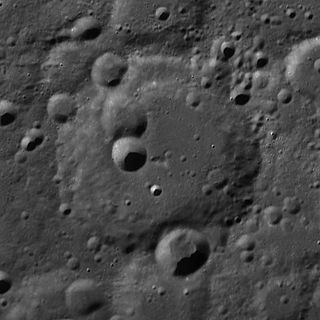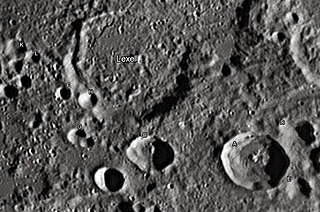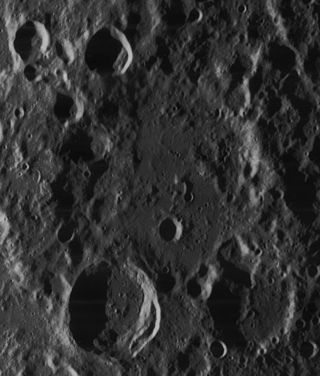
Clavius is one of the largest crater formations on the Moon and the second largest crater on the visible near side. It is located in the rugged southern highlands of the Moon, to the south of the prominent ray crater Tycho. It is named for the Jesuit priest Christopher Clavius.

Le Monnier is the remnant of a lunar impact crater that has been partly inundated by lava flows. It was named after French astronomer Pierre Charles Le Monnier. It is located on the eastern edge of Mare Serenitatis, and the western part of the rim is missing so that it now forms a large bay. To the north is the crater Chacornac.

Thomson is a lunar impact crater that is located within the Mare Ingenii on the far side of the Moon. Just to the northeast is the unusual merged crater formation of Van de Graaff. On the northwest rim of the mare is O'Day, and to the south-southwest is Obruchev on the southern shore of Mare Ingenii.

Ansgarius is a lunar impact crater that is located near the eastern limb of the Moon. When viewed from the Earth, the crater has a highly oval shape due to foreshortening, but the rim is actually nearly circular. To the northwest of Ansgarius is the crater La Pérouse, and south is Behaim.

Poincaré is a large lunar impact basin that lies in the southern hemisphere on the far side of the Moon. Most of the formation has been heavily eroded by subsequent impacts, leaving a battered formation with only rugged remnants of the original outer rim to the west.

Joliot is a large lunar impact crater that lies on the far side of the Moon, just past the eastern limb. At this location it lies in a region of the surface that comes into sight during a favorable libration, although at such times it is viewed from the side. Thus viewing this crater in detail must be done from orbit.

Fechner is a lunar impact crater that lies on the far side of the Moon's southern hemisphere, attached to the western rim of the large walled plain Planck. The eastern rim of Fechner intersects the Vallis Planck, a long, wide cleft in the surface that follows a course to the north-northwest. This valley intrudes into the southeastern rim of the crater, then continues northwards from the periphery of the northeast rim.

Becquerel is a lunar impact crater that lies in the northern hemisphere on the far side of the Moon. This is an ancient and heavily worn formation that is now little more than an irregular buri in the surface. The outer rim has been worn and reshaped until it forms a rugged, mountainous region around the flatter interior.

Desargues is an ancient lunar impact crater that is located near the northern limb of the Moon, on the western hemisphere. It lies nearly due south of the crater Pascal, and southeast of Brianchon. The proximity of this crater to the limb means that it appears highly elongated due to foreshortening, and it is difficult to discern details from the Earth.

De La Rue is the remnant of a lunar impact crater, or possibly several merged craters, creating a formation sometimes called a walled plain. It lies in the northeastern part of the Moon on the near side, and so appears foreshortened due to its location. This formation lies to the north-northwest of the prominent crater Endymion, just beyond the eastern extreme of Mare Frigoris. The crater Strabo intrudes into the northern part of De La Rue's northern rim, and the smaller Thales is attached to the northwestern part of the wall.

Fabry is a large lunar impact crater of the form termed a walled plain. It is located on the far side of the Moon, just beyond the northeastern limb. Parts of this area are sometimes brought into view by the effects of libration, but the terrain is seen from the edge and so not much in the way of detail can be observed.

Bolyai is an old lunar impact crater that is located in the southern hemisphere on the far side of the Moon. To the southeast of Bolyai is the crater Eötvös, and to the north is Neujmin. It is named after the 19th century Hungarian mathematician János Bolyai.

Cremona is a lunar impact crater that is located along the north-northwestern limb of the Moon. From the Earth this crater is viewed from the side, and the visibility is affected by libration effects. To be viewed in any detail, this crater must be seen or photographed from orbit. It is located midway between the crater Boole to the south-southeast and, on the far side of the Moon, the crater Lindblad.

Hell is a lunar crater in the south of the Moon's near side, within the western half of the enormous walled plain Deslandres. To the southeast, also within Deslandres, is the larger crater Lexell, and about 9° to the south lies the prominent Tycho crater. The crater received its name in 1935 after the Hungarian astronomer and ordained Jesuit priest Maximilian Hell. It has 19 satellite craters with diameters ranging between about 3 and 22 km. Nearly all Hell craters are relatively flat and shallow, with a sharp, well-defined rim and a typical diameter-to-depth ratio of about 10.

Lexell is a lunar impact crater that lies across the southeastern rim of the huge walled plain Deslandres, in the southern part of the Moon. It was named after Swedish-Russian mathematician and astronomer Anders Johan Lexell. To the northeast is the walled plain Walther, and to the south is Orontius, another walled plain.

Riemann is a lunar impact crater that is located near the northeastern limb of the Moon, and can just be observed edge-on when libration effects bring it into sight. It lies to the east-northeast of the large walled plain Gauss. To the southeast, beyond sight on the far side, is the crater Vestine.

Darwin is a lunar impact crater of the type categorised as a walled plain. It lies in the southeastern part of the Moon, and is sufficiently close to the limb to appear significantly foreshortened when viewed from the Earth. Attached to its southern rim is Lamarck. To the northeast is the dark-floored crater Crüger.

d'Alembert is a large lunar impact crater located in the northern hemisphere on the far side of the Moon, to the northeast of the somewhat smaller walled plain Campbell. Astride the southwest rim of d'Alembert is Slipher. To the north is the crater Yamamoto, and to the south-southwest lies Langevin. This walled plain has the same diameter as Clavius on the near side, making it one of the largest such formations on the Moon.

Chevallier is a lunar impact crater that is located in the northeastern part of the Moon's near side, about a crater diameter east-southeast of the prominent crater Atlas. To the south-southeast of Chevallier is the flooded crater Shuckburgh.

Cassini is a lunar impact crater that is located in the Palus Nebularum, at the eastern end of Mare Imbrium. The crater was named after astronomers Giovanni Cassini and Jacques Cassini. To the northeast is the Promontorium Agassiz, the southern tip of the Montes Alpes mountain range. South by south-east of Cassini is the crater Theaetetus. To the northwest is the lone peak Mons Piton.






















